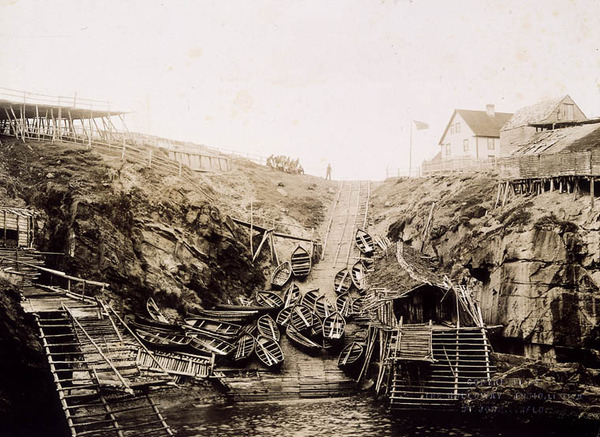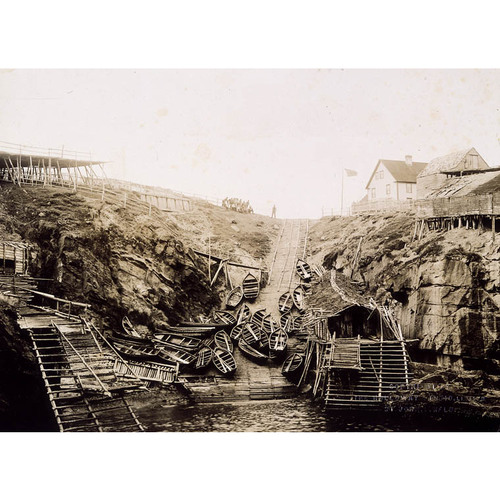HOLLOWAY, ROBERT EDWARDS, educator, scientist, and photographer; b. 30 Aug. 1850 in Barton-upon-Humber, England, son of William Holloway, a schoolteacher, and Mary Edwards; m. 25 June 1878 Henrietta Palfrey in St John’s, and they had one son and two daughters; d. there 14 Sept. 1904.
Robert Edwards Holloway arrived in Newfoundland in June 1874 to assume the duties of principal of the St John’s Wesleyan Academy. Having attended the Wesleyan Training College in London and received a ba from New College in Eastbourne, he had been invited to accept the position by the Reverend George Seaton Milligan on behalf of the board of directors. His term of appointment was to have been four years but he ably filled the position for thirty, until the day of his death. During his tenure the academy (later the Methodist Academy and then the Methodist College) undertook a major expansion, with an enthusiastic board providing enviable support.
There is no indication that Holloway completed courses for a degree in science, but scientific study occupied much of his life. Although a first-class laboratory had been planned for the academy before his arrival, it was he who set it up. He passed on his interest in science not only to his pupils but also to the general public, for whom he gave demonstrations and lectures at the academy and at the St John’s Athenæum, the cultural centre of the city before its destruction by fire in 1892. Fascinated with electricity and how it might be used by society, he was also intrigued by the work of Mme Curie, so much so that he acquired a small amount of radium with which to study its effects personally. He also followed the career of Wilhelm Conrad Röntgen, the discoverer of X-rays, and lectured on their application. Having acquired the proper equipment, he set up his own X-ray apparatus and used it, with some success, to treat several patients.
Holloway’s interest in photography arose from his desire to know how the process worked, but he came to love the camera and what it could do. Suffering all his life from tuberculosis, he would travel each summer to a far area of Newfoundland to ease the effects of the disease. He documented these trips with hundreds of exquisite glass-plate negatives, many of which survive today. These images would form the basis of Through Newfoundland with the camera, an album of 115 photographs. Published posthumously in 1905, it is considered a masterpiece. The book was intended by Holloway to interest tourists in the grandeur of the country and businessmen in its potential for investment. It proved so popular that a second edition, revamped by his family, was brought out in 1910.
Holloway was a many-faceted individual. For some years he served on the Council of Higher Education, which regulated the syllabus for school examinations, and in his last years he filled the position of public analyst in the Department of Agriculture and Mines. In 1881 he was a founding member of the Newfoundland Historical and Statistical Society. He formed and acted as president of the Holloway Athletic Association and in 1896 he founded a photography society for amateurs.
In 1904 Holloway succumbed to the disease that had gradually sapped his tremendous energy. Four years later a monument, specially imported from Scotland, was placed over his grave “by friends, associates and pupils in appreciative recognition of the varied gifts and scholarship which he employed with such unceasing energy as to leave a lasting impression upon the work of Education in Newfoundland and to render his own brief life-work brilliantly successful.” In 1929 his old college, the scene of most of his experiments, would be renamed Holloway School in his honour.
Four years after Holloway’s death his son and daughter opened Holloway Studio in St John’s. Constructed specifically as a photographic workplace, it was ahead of its time. During World War I, in April 1917, Robert Palfrey Holloway, a lieutenant in the Newfoundland Regiment, went out into no man’s land and was never seen again. Elizabeth (Elsie) Holloway carried on the studio until the late 1940s, achieving an enviable reputation as a portrait photographer, especially of school children.
The Holloway collection of glass-plate negatives is preserved in the Still and Moving Images Sect. at the PANL.
GRO-L, Barton-upon-Humber, Lincolnshire, birth certificate, 30 Aug. 1850. PANL, St John’s West Circuit (Methodist), reg. of baptisms, 1887–88 (copy). PRO, CO 199/72 (Nfld, Blue book, 1876). UCC, Newfoundland Conference Arch. (St John’s), Wesleyan Academy, later Methodist College (St John’s), board of directors, minutes, 1858–86. Daily News (St John’s), 1904. Evening Herald (St John’s), 1902, 1908. Evening Telegram (St John’s), 1896, 1904. Newfoundlander, 1874. Public Ledger, 1878. Royal Gazette and Newfoundland Advertiser, 1874. Almanac, Nfld year book, 1900, 1903. A century of Methodism in St. John’s, Newfoundland, 1815–1915, ed. J. W. Nichols (St John’s, [1915]). Collegian ([St John’s]), 1962–63. Univ. of London, General register, 1901.
Cite This Article
Anthony P. Murphy, “HOLLOWAY, ROBERT EDWARDS,” in Dictionary of Canadian Biography, vol. 13, University of Toronto/Université Laval, 2003–, accessed April 5, 2025, https://www.biographi.ca/en/bio/holloway_robert_edwards_13E.html.
The citation above shows the format for footnotes and endnotes according to the Chicago manual of style (16th edition). Information to be used in other citation formats:
| Permalink: | https://www.biographi.ca/en/bio/holloway_robert_edwards_13E.html |
| Author of Article: | Anthony P. Murphy |
| Title of Article: | HOLLOWAY, ROBERT EDWARDS |
| Publication Name: | Dictionary of Canadian Biography, vol. 13 |
| Publisher: | University of Toronto/Université Laval |
| Year of revision: | 1994 |
| Access Date: | April 5, 2025 |





